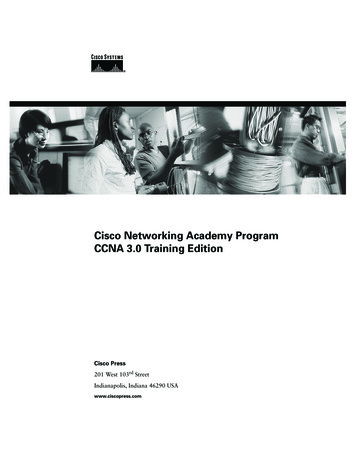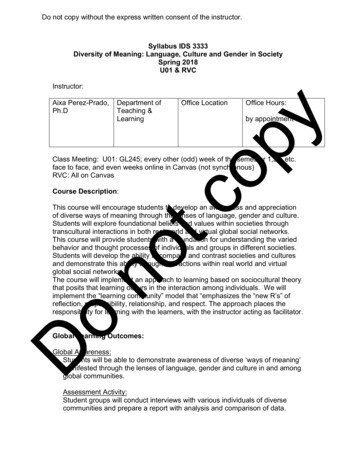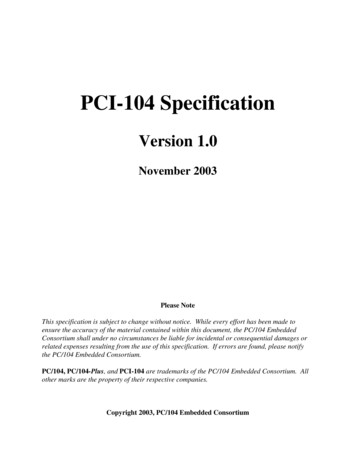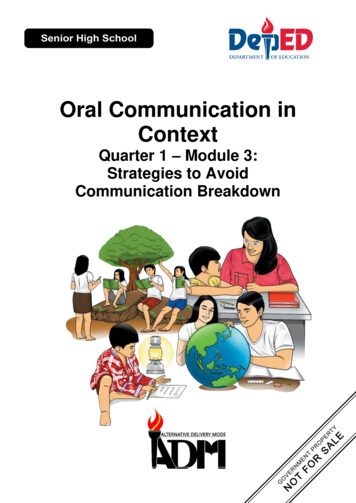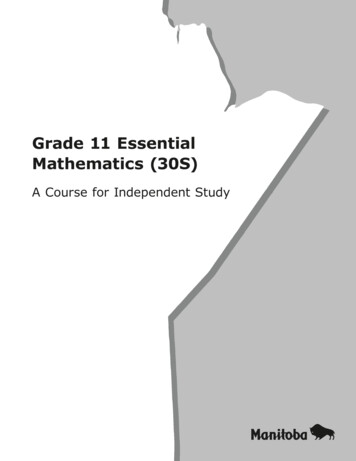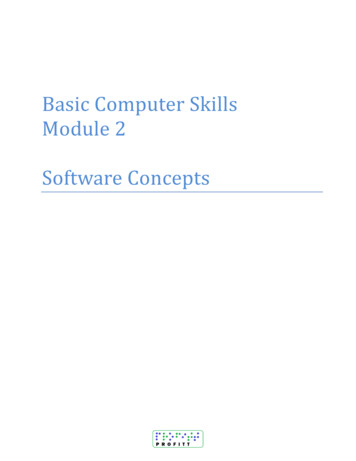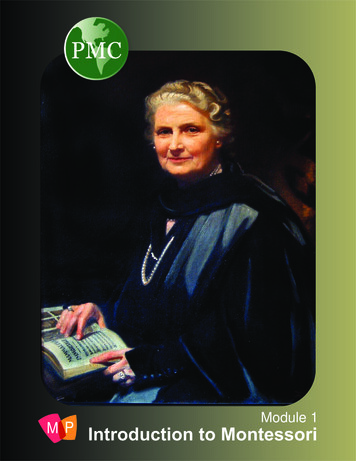
Transcription
Module 1M P Introduction to Montessori
MontessoriTrainingProgramContentsWelcome to Montessori Pakistan (MP)’s internationally recognized PreschoolMontessori Teacher Training Program, which has been designed for trainingteachers, professional care-givers and mothers to teach children aging 2.5 to 6 years ofage. This course material is accredited by Pakistan Montessori Council (PMC) andInternational Montessori Training Organization (IMTO), UK. It is a product of years ofconcentrated efforts on the part of MP’s experts. We feel proud to affirm that this is byfar the most up to date, convenient, comprehensive, cost-effective and demand drivenMontessori training program, which does not only allow you to have the training at theconvenience of your home, but also opens sure chances of employment in thousandsof Montessori schools worldwide. It, furthermore, equips you with all the skills andknowledge to start your own Montessori school.The course material consists of highly illustrated 12 training manuals, which contain themost up to date Montessori training content. The first rated material will be a life timeteaching resource for you, either you are a mother, teacher or are running your ownMontessori house of children. The manuals include;1.2.3.4.5.6.Introduction to MontessoriExercises of Practical Life (EPL)Sensorial ExercisesLanguage ExercisesLanguage Exercises (Advanced)Arithmetic Exercises7. Arithmetic Exercises (Advanced)8. Culture 1 (Everyday Science)9. Culture 2 (Geography, Botany & Zoology)10. Culture 3 (Handwork)11. Cosmic peace Education12. Montessori School AdministrationEach module provides a deep insight into the concerned area of Montessori education.All Montessori classroom activities are described in simple language and are supportedwith examples, illustrations and pictures. The concepts are further reinforced throughprojects and assignments to be done by the trainee with the help of the online trainers.The supplementary audio version of this book is available in the accompanying CD.Listening to the CD is like listening to lectures, which helps you understand conceptsfurther. Secondly, the supplementary listening books have been designed with the hopethat they would help many to improve their language skills and get ability to vocalizetheir learning. Thirdly, the audio books are an interesting way to go through your coursematter without actually reading it; you can listen while you sit back and relax, lie down oreven when you are driving your car or working in the kitchen. Finally, the hands-onpractical training sessions, which are a mandatory part of the course, make the alreadylearnt concepts concrete in the mind of the trainee. We strongly recommend tooverseas Pakistanis and foreigners (for whom the practical part of the training has beenmade optional) that they join a school, where Montessori Method is being used forhands-on experience with materials as a trainee teacher.1Montessori Method(An overview)12Life & Works of Dr. MariaMontessori33The Discovery of the Child94Why Send Children to aMontessori House ofChildren?125Principles of MontessoriEducation156Sensitive Period207Montessori’s Approach toDiscipline228Importance of Movement inChild Development259Montessori Teacher or Guide2910Montessori Peace Education3211Three Period Lesson3412Montessori ClassroomDesign3613Child Development39
Chapter 1MontessoriMethod(An Overview)If education is always to be conceived along the same antiquated linesof a mere transmission of knowledge, there is little to be hoped from itin the bettering of man's future. For what is the use of transmittingknowledge if the individual's total development lags behind?Dr. Maria MontessoriMost of us have been to preschool, primary school and high school, but we know that passingexaminations or getting degrees alone does not prepare us for life. However Montessori education, whenproperly implemented does prepare children for life, especially for life in the 21st century. It lays a strongfoundation by helping the child to help himself.Dr. Maria Montessori is the founder of Montessori system of education. She emphasized the need forearly education. It was much later that educational research verified that early years are the mostimportant years of a person's life. Early childhood is the only period, when qualities of mind, character andbody can be absorbed, so as to form an inherent part ofthe individual's personality. This is the time whenfoundation of an integrated personality can be laid.Growing awareness of this fact and the desire on part ofparents to give the best to their children, leads them toseek Montessori education for their children.How did Dr. Montessori, a physician who was born beforethe twentieth century began, and died in the middle of it,developed an educational approach that prepares youngpeople for the 21st century? The answer is elegant in itssimplicity. She observed children, looking for behavioralpatterns in their interaction with the environment. Sheconducted many experiments in various parts of theworld. Her life long observations and inferences, led to the'Discovery of the Child'. Due to the scientific, experimentalmethods of investigation followed by her on a largegeographical scale (Montessori schools all over theworld), she was able to assert her findings with greatauthority. She also explains in a convincing manner thatmost of our social and individual problems have theirMontessori Pakistan (pvt) Ltd11
Chapter 1Introduction to Montessoriorigin in the fact that the child's vital needs during his growing up phase are overlooked or trampled upon.Observation showed Dr. Maria Montessori that children are like absorbing machines, as if there isvacuum in their minds. There is an inner urge for more and more knowledge. The mind is like soft wax,susceptible at this age to impressions, which could not be taken at a later stage. Dr. Maria Montessorifound that the patterns of behavior in small children are universal and not altered by culture or birth.Dr. Montessori's experiments were centered on the child. She looked for nature's pattern of developmentand the needs of the growing child. Her system of education is therefore, adapted to the child's interest.The child concentrates with enthusiasm and grows intellectually and emotionally. During 3 to 6 years ofage the child begins to absorbs consciously from the environment and becomes harmonious inmovement, independent in work and an honest and helpful individual. Adults should not impose theirideals on children. The only role an adult needs to play is to ensure freedom and provide the right kind ofenvironment to help the child achieve his own goals which match his psyche and genetic makeup. If theright environment is provided, the children learn automatically what they should learn and they are able toset their goals as well without any kind of teaching. When we realize this we learn modesty, patience andrespect for the child.Education is not merely learning of various subjects and increasing your quantum of knowledge.Knowledge is necessary, but not sufficient. It is important for a child to grow into a well developedpersonality who knows how to love a healthy life in every aspect of human existence. Education has tobe an effort to help the child live his life as he is meant to and to actualize his inner potential. Dr.Montessori viewed education as an aid to life, which actually begins at birth and continues throughout thecourse of development. Learning has to be done at the pace and rhythm of the learner and not dictated bythe teacher. Nature has a specific time frame for all developmental activities in a child. The adult needs toobserve objectively the requirements of the child at each stage of development. The teacher/adult shouldavoid offering help directly. Direct teaching, however well done, creates a situation of superiority andinferiority. Constant supervision and correction also weaken confidence and therefore self reliance.Adults need to learn self restraint, as most of us feel compelled to unnecessarily correct the child or offersuperfluous help.Montessori Pakistan (pvt) Ltd21
Chapter 1Introduction to MontessoriSome Research Results about MontessoriResearch has proved that children in Montessori classrooms develop theircapabilities in unique ways. Montessori Children seem happier, are lessdemanding and are easier to live with than other children of the same age,who have not had similar assistance in their development. Visitors to aMontessori House of children are amazed to see little children, barely outof their diapers, working with concentration and purpose on activities oftheir choice. There is order and peace. The sight of a 22 months old,spreading dough with a rolling pin and using a cutter to form the shapes orputting on their own aprons, gathering materials, carefully holding thebrush, making a painting that pleases them and attaching it with aclothespin to the drying rack – all with minimal need for assistance, comesas a surprise to adults. Children are also seen spontaneously cleaning upfor each other when accidents happen. They learn to wait their turn, walkaround each other without bumping and share the attention of the adult.The look of pride and self satisfaction on the child's face after eachaccomplishment is a clear indication that inner development is takingplace. There is no fatigue in these children. Sense of accomplishment fillsthem with renewed energy. They seem to be as fresh as they were in themorning, when their parents come to collect them in the evening. Thefollowing excerpt from Wikipedia Encyclopedia quotes the findings ofsome researchers.“Angeline Stoll Lillard's award-winning 2005 book Montessori: TheScience Behind the Genius (Oxford University Press) presents the firstreally comprehensive overview evaluating Montessori versusconventional education in terms of research relevant to their underlyingprinciples. Lillard cites research indicating that Montessori's basicmethods are more suited to what psychology research reveals abouthuman development, and argues the need for more research.A 2006 study published in the journal "Science" concluded that Montessoristudents (at ages 5 and 12) performed better than control students whohad years prior lost the random computerized lottery to go to Montessoriand instead went to a variety of different conventional schools. This betterperformance was obtained in a variety of arenas, including not onlytraditional academic areas such as language and math, but in social skillsas well.On several dimensions, children at a public inner city Montessori schoolhad superior outcomes relative to a sample of Montessori applicants who,because of a random lottery, attended other schools. By the end ofkindergarten, the Montessori children performed better on standardizedtests of reading and math, engaged in positive interaction on theplayground more, and showed advanced social cognition and executivecontrol more. They also showed more concern for fairness and justice. Atthe end of elementary school, Montessori children wrote more creativeessays with more complex sentence structures, selected more positiveresponses to social dilemmas, and reported feeling more of a sense ofcommunity at their school.The authors concluded that, "when strictly implemented, Montessorieducation fosters social and academic skills that are superior to thosefostered by a pool of other types of schools." Research by K. Dohrmannand colleagues supplements this by showing superior math and scienceperformance in high school by children who previously attended publicMontessori (as compared to high school classmates, over half of whomwere at the most selective city public high schools); and two studies byRathunde and Csikszentmihalyi showing a higher level of interest andmotivation while doing school work as well as more positive socialrelations among Montessori middle-schoolers as opposed to matchedcontrols.”Montessori Pakistan (pvt) Ltd31
Chapter 2Life & Worksof Dr. MariaMontessoriThis biography of Dr. Montessori is an adapted and extended version of the "MariaMontessori’s Biography" Encyclopedia of Education. The Gale Group, Inc, 2002.Answers.com 17 Apr. 2008 authored by Timothy David SeldinDr. Montessori is recognized as the founder of Montessori Method and one of the pioneers in thedevelopment of early childhood education. She is also respected and reputed for promoting a substantialnumber of important educational reforms, which now have become integral components of 21st century'seducational core.Montessori was born on 31st August 1870to an educated middle-class family inAncona, Italy. She was the only child ofher parents. Her father's name wasAlessandro Montessori and he was aconservative military man. On the otherhand, her mother, Renidle Montessori,was a liberal lady and supported Maria'seducational pursuit. Her father's frequenttransfers gave Maria a chance to haveeducation in big cities throughout Italy.Almost whole of Europe, in those days,was very conservative in its attitudetoward and treatment of women. Italywas no exception but Montessoripursued medical and scientificeducation. Despite many years ofopposition from her father, teachers, andmale fellow students, she graduated withhighest honors from the Medical Schoolof the University of Rome, becoming thefirst woman physician in Italy in 1896.Thus, Montessori holds the title of beingthe first lady doctor in the history of Italy.Montessori Pakistan (pvt) Ltd41
Chapter 2Life & Works of Dr. Maria MontessoriWork with Special ChildrenMontessori was always unwilling to entereducation as a career as it was one of the threetraditional roles open to women at that time:working with children, homemaking or theconvent. But the ironic thing is that she becamebest known for her contributions in education. As aphysician, Montessori specialized in pediatricsand the new field of psychiatry. Her approach wasmore scientific, rather than the familiarphilosophical approach followed by many of theeducational innovators who came before and afterher.Montessori taught at the medical school of theUniversity of Rome, and through its free clinics shecame into frequent contact with the children of theworking class and poor. Her experience with thechildren of poverty convinced Montessori thatintelligence is not rare, although it seemed topresent itself in many forms other than thoserecognized by traditional schools.In 1900, at the elapse of just a short span of fouryears after her degree in medicine, Montessoriwas appointed director of the new OrthophrenicSchool attached to the University of Rome,formerly a municipal asylum for the "deficient andinsane" (special) children of the city, most of whomwould be diagnosed in the twenty-first century asautistic* or mentally disabled. One day sheMontessori Pakistan (pvt) Ltdinquired from a nurse about their awful condition,to which she replied that they fought for food andthrew themselves on the floor to catch breadcrumbs that was how they got dirty. Thus, thechildren were kept in a prison like room with lessfood and no hopes of recovery. She and hercolleagues started a wave of reform in the51
Chapter 2Life & Works of Dr. Maria Montessoriinstitution. Montessori discovered that her youngpatients needed purposeful activities, which couldstimulate their senses and mind, and add into theirself-esteem, and the sense of achievement.Montessori dismissed the nurses and caretakerswho treated those children with hatred andcontempt. This caused a great scarcity of staff.However, Montessori set out to teach as many aspossible of the less-disturbed children to care forthemselves and their fellow inmates.Inspiration from Itard and SéguinFor almost a year (from 1900 to 1901), Montessoribrowsed the medical libraries of Western Europeseeking successful work previously done with theeducation of children with disabilities. During herhunt she got inspired by the work of two almostforgotten French doctors of the eighteenth andnineteenth centuries: Jean-Marc-Gaspard ItardWild Boy of Aveyronboy had grown up outside of human societywithout the influence of interaction with his ownkind. Itard started a study of the boy in order toshed some light on the age-old debate about whatproportion of human intelligence and personalityis hereditary (genetic) and what proportion stemsfrom learned behavior (environmental influence).This experiment was a limited success. Itardfound his wild boy uncooperative and unwilling orunable to learn most things. This led him topostulate the existence of developmentalperiods in normal human growth. He formedthe hypothesis that, during these "sensitiveperiods," a child must experience stimulation todevelop normally, or he will grow up foreverlacking the skills and intellectual concepts notdeveloped at the stage when nature expects themto be readily absorbed. In simple terms, ifappropriate experiences are not available atspecific times during development in earlyyears, it may get hindered or does not takeplace at all.Jean-Marc-Gaspard ItardAlthough Itard's efforts to teach the wild boy werebarely successful, his work had two importantimplications;(1775 - 1838) and Édouard Séguin (1812-1880).Itard is well known even today for his work with the"Wild Boy of Aveyron", a young boy who was foundby some hunters wandering naked in the forest.1) If proper stimulation and experiences arenot provided during sensitive periods ofdevelopment to a child, it may hinder ordoes not take place at all.The boy was, presumably, lost or abandoned as avery young child and thus spent many years of lifealone in the forest. The boy could not speak andlacked almost all of the skills of everyday life. ThisMontessori Pakistan (pvt) Ltd2) Furtherance of handicapped children ispossible.61
Chapter 2Life & Works of Dr. Maria Montessorieducational method, and carefully noted theirresponse to her attempts as well as their progressin becoming increasingly independent and verbal.She almost startled the whole world when many ofthese mentally disabled children, after two years,were able to pass the standardized exams givenby the Italian public schools. Gradually thechildren also learned to perform most of theeveryday tasks involved in preparing the mealsand maintaining the environment of the residentialschool.Just when her work with mentally challengedchildren got recognition and fame, anotherquestion began to haunt her mind “What keptnormal children back” in the exams. Montessoriresponded by suggesting that newborn humanÉdouard Séguin (1812-1880)Montessori drew further confirmation of Itard'sideas from the work of Édouard Séguin, a Frenchpsychologist who was a student of Itard andcarried on his research. His work, however, wasfar more specific and organized. He also managedto apply his ideas to the everyday education ofchildren with disabilities. Working primarily withthe blind, Séguin developed a methodicalapproach to breaking skills down into small steps,and was highly successful with a carefullydeveloped collection of hands-on educationalmaterials. Teens and Tens boards, now used as aMontessori material, were also originally designedby Seguin.beings normally enter the world with anintellectual potential that was barely beingdeveloped by schools in the early years of thetwentieth century. She challenged that if she couldattain such results with children who weredisabled, schools should be able to getdramatically better results with normal children.Montessori's work strengthened her humanisticideals, and people began to regard her as areformer. She actively supported various socialreform movements. She was a highly respectedand frequently invited guest speaker throughoutEurope on behalf of children's rights, the women'smovement, peace education, and the importanceof the League of Nations. Montessori become wellknown and highly regarded throughout Europe,which contributed to the publicity that surroundedher schools, started just a little later.The Orthophrenic SchoolFrom Itard and Seguin, in the real sense,Montessori took the idea of a scientific approach toeducation, based on observation andexperimentation. She belongs to the child studyschool of thought. She continued her work with thecareful practice and objectivity like that of abiologist studying the natural behavior of ananimal in the forest.Casa dei BambiniMontessori studied her mentally disabled patientswith utmost zeal. She kept on trying Seguin'sMontessori, now, being intoxicated by the newzest of her life, the desire to implement herMontessori Pakistan (pvt) Ltd71
Chapter 2Life & Works of Dr. Maria MontessoriThe first Montessori House of Children (Casa dei Bambini) with children workingand a lot of visitors getting amazed around the fencemethod on normal children, began to look out foran opportunity to work with normal children.Unfortunately, the Italian Ministry of Education didnot welcome Montessori's ideas, and she wasdenied access to school-aged children. However,the opportunity came to her itself in 1907, whenshe was offered the position of a the medicaldirector for a day-care center that was beingorganized for working-class children who were tooyoung to attend public schools.of them were aggressive, impatient and cranky. Atthis stage, Montessori did not know if herexperiment would work under such conditions.However, she, not caring about the odds, beganby teaching the older children how to help out withthe everyday tasks that needed to be done. Shealso introduced the hand-on materials ofperceptual discrimination and puzzles and eyehand manipulative exercises that she had usedwith mentally disabled children.This first day-care center, named Casa deiBambini (House of Children) was inaugurated in1907 and was located in the worst slum district ofRome, and the conditions Montessori faced werehorrendous. There was only one untrainedteacher to teach her first class which consisted offifty children, from two through five years of age. Itwas an extended day school and the childrenremained at the center from morning till eveningwhile their parents worked. The children were alsogiven two meals per day, bathed regularly, andgiven a program of medical care. The childrenthemselves were the products of extreme innercity poverty conditions and ignorance of theparents. Almost all of them came to Children'sHouse on the first day crying and reluctantly. MostMontessori must have had some hope of successbut the results surprised her. The materialsseemed to be working miraculously. Unlike hermentally challenged children who had to bepushed to use her apparatus, the normal childrenwere naturally attracted to the work sheintroduced. The aimless street wanderers beganto settle down. They began to show longer andlonger periods of constructive activity. They werefascinated with the puzzles and perceptualtraining devices.Montessori Pakistan (pvt) LtdMontessori introduced exercises of practical dayto day living like cleaning, dressing, gardening,etc. and to her amazement, children aging threeand four years took the greatest delight in learningpractical everyday living skills. She noticed that81
Chapter 2Life & Works of Dr. Maria Montessorisimilar in all children and are the product ofmillions of years of evolution. Nature, itselfencourages children to select the activities, whichare appropriate for development at that stage. Toher, a child who fails in school should not beblamed, any more than a doctor should blame apatient who does not get well fast enough. Just asit is the job of the physician to help people find theway to cure themselves, it is the educator's job tofacilitate the natural process of learning.such activities made them more independent andadded to their self-respect. Their interest wasdeveloping day by day and they progressed sorapidly that each day they pleaded Maria to showthem more. The older children began to take careof the school. They also assisted their teacherswith the preparation and serving of meals and themaintenance of a spotless environment. Thedecipline problems vanished dramatically. Thechildren running wild in the street had turned tomodels of grace and courtesy in just a short spanof time.Montessori's children showed tremendousprogress into academics and each achievementwas like a sudden explosion. The children weretoo young to be sent to public schools, yet theyliterally begged to be taught how to read and write.They learned to do so quickly and enthusiastically,using special manipulative materials. Montessorijust kept on noticing the inclinations of the childrenand developed manipulatives accordingly. Theother area, which fascinated the children, wasnumbers. To respond to their interest, themathematically inclined doctor developed a seriesof concrete math learning materials. TheseMontessori, when criticized of her method beingtoo structured and academically demanding ofyoung children, laughed out saying, "I followedthese children, studying them, studied themclosely, and they taught me how to teach them."Talking about the role of the teacher, she arguedthat the educator's job is to serve the child,determining what each student needs to make thegreatest progress. She believed that childrenfollow their inner strong urges to select theiractivities and work. These urges are universallyMontessori Pakistan (pvt) Ltd91
Chapter 2Life & Works of Dr. Maria Montessorimaterials are so comprehensive and yet concretein nature that they still fascinate manymathematicians and educators to this day. It didnot take those three, four and five years old long tostart adding and subtracting four-digit numbers.They further progressed on to multiplication,division, skip counting, and increasingly advancedand abstract concepts.Montessori discovered an unlimited potential inchildren to learn. They began to show interests inother areas as well. This compelled the alreadyoverworked doctor to spend night after nightdesigning new materials to keep pace with thechildren in geometry, geography, history, andnatural science. Montessori discovered that herchildren showed more interest in academicmanipulatives rather than toys. She made thisdiscovery shortly after her first school opened,when a group of well-intentioned women gave thechildren a collection of lovely and expensive toys.The children took profound interest in those newgifts for a few days, but they soon returned to theirlearning materials. She also found that childrengenerally preferred work over play, at least duringthe school day."Children read and do advanced mathematics inMontessori schools not because we push them,but because this is what they do when given thecorrect setting and opportunity. To deny them theright to learn because we, as adults, think thatthey should not is illogical and typical of the wayschools have been run before.”Montessori method wasn't so perfect since dayone. She improved it through trial and error. Shecontinued to observe the children deeply, madeeducated guesses and finally experimented. Forexample, one day the teacher arrived late at thecenter. The children, meanwhile, had crept inthrough the window and started their work. Theyeven took the material themselves from thecupboard, which normally used to be locked, butwas open just by chance. She, instantly,recognized that the children were capable ofselecting their own work, and removed the cabinetand replaced it with low open shelves on which theactivities were always available to the children.This seems to be a small change, but it actuallywas against all the educational theories andpractices of that time.Worldwide ResponseMaria Montessori's first Casa dei Bambini becamefamous in the entire world in a very short span oftime. Thousands of visitors went away amazedand enthusiastic. After the success of her firstMontessori Pakistan (pvt) Ltd101
Chapter 2Life & Works of Dr. Maria Montessorischool, she started the second one and then thethird and so on. Her system worked everywhere inso many different settings. Montessori becamethe interest of leaders and scientists around theworld. Even, in America, figures like as WoodrowWilson, Alexander Graham Bell, Thomas Edison,and Henry Ford supported and praised her work.Numerous publication and articles written aboutand by Montessori, made her a well-knownpersonality to parents and teachers.The most incredible thing about Montessorimethod is that her model center (Casa deiBambini) got duplicated everywhere, which is arare attribute, as in this field many others hadpromoted opinions, philosophies, and models thathave not been readily duplicated. The Montessorimethod is the most systematic system ofeducation that gets applied very well to newsettings. In the first thirty years of the twentiethcentury, the Montessori Method seemed to offersomething for everyone. For instance, scholarsfrom conservative school of thought valued thecalm, responsible behavior of the little children,along with their love for work. People with liberalapproach highly praised the freedom andspontaneity. Many political leaders andeducationists saw it as a way to reform the oldfashioned school systems of Europe, NorthAmerica, and Asia, as well as an approach thatthey hoped would lead to a more hardworking,peace loving and disciplined population.Scientists of all disciplines praised Maria'sobjectivity and the experimental foundation of thismethod. At one time the wave of support andenthusiastic praise for Maria was so high thatmany began to anticipate a dramatic change in theface of education, which unfortunately did nothappen that fast.The Decline and Revival of Interest inMontessori EducationThe number of Montessori schools soared up to1000 by 1925 and many tens of thousands morearound the world. But things took a dramatic turnby 1940. Montessori movement virtuallydisappeared from the American scene anddeclined in many other countries. In America, onlya few schools had the courage to pronouncethemselves
Montessori Method (An overview) 1 2 Life & Works of Dr. Maria Montessori 3 3 The Discovery of the Child 9 4 Why Send Children to a Montessori House of Children? 12 5 Principles of Montessori Education 15 6 Sensitive Period 20 7 Montessori



